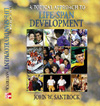|
 |  Life-Span Development: A Topical Approach John W. Santrock
Cognitive Processes and Development Language Development
Chapter Outline- WHAT IS LANGUAGE?
- Defining Language
- Language's Rule Systems
- Phonology
- Morphology
- Syntax
- Semantics
- Pragmatics
- BIOLOGICAL AND ENVIRONMENTAL INFLUENCES
- Biological Influences
- Biological Evolution
- The Brain's Role in Language
- Biological Prewiring
- Is There a Critical Period for Learning Language?
- Behavioral and Environmental Influences
- An Interactionist View of Language
- HOW LANGUAGE DEVELOPS
- Infancy
- Earliest Communications
- Receptive Vocabulary
- One-Word Utterances
- Two-Word Utterances
- Mean Length of Utterance (MLU)
- Early Childhood
- Rule Systems
- Phonology
- Morphology
- Syntax
- Semantics
- Pragmatics
- Overview of Early Language Development
- Middle and Late Childhood
- Vocabulary and Grammar
- Reading
- Writing
- Bilingual Education
- Adolescence
- Adulthood and Aging
|
|
|



 2002 McGraw-Hill Higher Education
2002 McGraw-Hill Higher Education